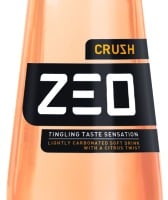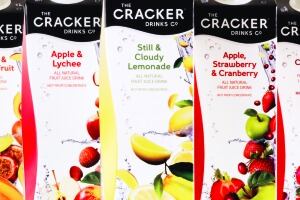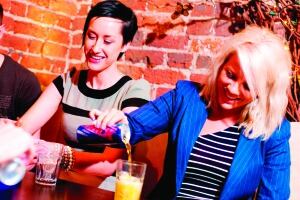The new Britvic Soft Drinks Review cites strong growth from energy drinks, flavoured carbonates, juice drinks and lemonade, though squash, fruit juice and mineral water are all in double-digit decline.
53%
the proportion of soft drinks served in draught format
In both percentage and volume-growth terms, some of the fastest-growing brands within the on-trade top 20 support the trends identified by Britvic: Tango, Schweppes Lemonade, Red Bull and Fruit Shoot all did well. Britvic pure juice mixers, Schweppes and Strathmore water were among the fastest fallers.
45%
the proportion of soft-drinks volumes accounted for by cola
Overall, says market data supplier CGA Strategy, total soft drinks are outperforming the drinks market as a whole in the on-trade.

Though volumes for the year to March were down 1.6%, the value of sales rose 4.3% over the same period, smashing the £4bn barrier and suggesting on-trade operators are successfully achieving higher prices and margins for their soft drinks.
CGA account manager Simon Stobart says: “Draught is still the dominant format for more than 53% of all soft-drinks serves and has remained stable in the past year.
“There are two categories that drive a lot of the soft-drinks performance — cola and lemonade. Unsurprisingly, both of these can be expected to be served in draught format by almost every on-trade outlet. They are staple soft-drinks categories — cola accounts for nearly 45% of all volumes, with lemonade on 17%.”
While those categories represent scale, much of the noise in soft drinks is coming from new entrants with premium price positions and enticing margins. Natural, adult and with-food are common themes for many of them.
For licensees, there’s a balance to be struck between the abiding popularity of traditional soft drinks and exciting customers with something new.

Wes Mckenna, cold-channel director at Coca-Cola Enterprises (CCE), says: “In some outlets, the soft-drinks offering can be fairly limited, so consumers revert to trusted favourites such as a cola, lemonade or orange juice, which they know will be available.
“However, 83% of customers would appreciate a more interesting recommendation.”
Mckenna says CCE’s Appletiser and Ocean Spray brands fall into the category of premium soft drinks that complement food.
“Incidence with food in pubs is currently high, at 44.2%, and soft drinks remain the most popular beverage choice with food in both pubs and restaurants,” he claims.
Cawston Press has launched a new range of sparkling soft drinks for adults with high levels of pressed fruit juice and all-natural ingredients.

Managing director Mark Palmer says: “In the same way that tastes have become more sophisticated when it comes to food and alcohol, soft drinks are now moving in this direction.
“Typically, many soft drinks traditionally available in the on-trade have been sickly sweet at a time when customer palates are becoming more discerning. A new generation of grown-up soft drinks is emerging, with higher-quality ingredients and a more adult taste profile. These tend to involve more complex recipes and lower overall levels of sugar and sweetness.”
This theme is echoed by Martin Hall, chief executive of Freedrinks, which is initially launching its Zeo brand into the London and Brighton on-trades, with a £4.2m support package including TV, cinema and press advertising.
Each 27.5cl bottle of Zeo Burst (peach and grapefruit), Crush (blood orange and citrus) and Zest (twist of lime) has fewer than 60 calories and contains a blend of 32 herbs and botanicals, which mimic the palate delivery — or tingle — of a 30% ABV spirit, according to the company. Hall says that the aim is to provide adults with a grown-up alternative to alcohol.

£4.2m
the support for the Zeo brand launch in London and Brighton
“It has complexity of flavour rather than being sweet and sickly,” says Hall. “Wine drinkers are the same age profile as adult soft-drink consumers, yet 90% of wines are medium dry to dry and 99% of soft drinks are sweet. It’s a missed opportunity for the soft-drinks market.”
Hall believes publicans are missing out on a big opportunity for extra sales by not actively promoting premium, adult soft drinks. He says Zeo should typically have a 40p to 50p premium over a same-size Coke serve.
“A lot of soft-drink sales are being lost to tap water, which pubs can’t charge for,” says Hall.

“It’s a big issue, but it’s also a big opportunity if pubs can offer customers soft drinks with the complexity of flavour that they expect from alcoholic drinks.”
Halewood International has entered the adult soft-drinks arena with its John Crabbie’s range, including the new Scottish raspberry with ginger and lemonade with ginger varieties.
Ron Young, managing director for Halewood’s soft-drinks business, says: “Feedback from pubs shows that they are looking for credible, great-quality, adult soft drinks for those who don’t wish to drink alcohol, and Halewood has deliberately chosen interesting and unusual flavours that are targeted at adults.
Feedback from pubs shows they want credible, adult soft drinks for those that don’t drink alcohol
“Consumers want to treat themselves when they’re out and about, and quality, crafted soft drinks allow publicans to offer consumers the chance to trade up.”

Cracker Drinks Co has undertaken a redesign for the packaging of its one-litre natural fruit juice drinks, which include unusual flavours such as apple, strawberry & cranberry; pineapple, guava & lime; and still & cloudy lemonade. The company has been working with Mitchells & Butlers on premium pours and recently won listings with Whitbread and Marston’s.
Managing director Gavin Cox says: “A focus on adding value in other ways than just price is becoming essential.
“Consumers are becoming more and more demanding of this. Some of the strong consumer trends over the past couple of years have been the quality of ingredients used, the natural aspect of the product, and growing interest in new flavours such as exotic blends.”

The main message to pubs is to offer choice. The trade is still guilty of a lot of duplication
Belvoir Fruit Farms has been chipping away at the grown-up, high-margin packaged soft-drinks market for nearly 30 years. Its best-selling single-serve drinks are 25cl elderflower pressé, raspberry lemonade and ginger beer.
Belvoir managing director Pev Manners says: “The on-trade seems to concentrate on alcohol because it has cash margins, but it needs to recognise that packaged soft drinks can offer this too.

“A lot of operators seem slightly in thrall to post-mix because of the massive margin, but it’s not what a lot of discerning customers want to drink.”
SHS Drinks also has long-standing players in adult soft drinks in the Bottlegreen and Shloer brands.
Head of brand marketing Amanda Grabham says: “The main message to pubs is to offer choice. The trade is still guilty of a lot of duplication. Sometimes, there will be three different orange juices in the fridge and very little real choice.”
The company is looking to inject some choice and excitement into mixers with the launch of its pomegranate and elderflower-flavoured tonic waters under the Bottlegreen brand. Mixers showed a 4.6% decline last year, largely impacted by the growth of energy drinks as a mixer.

“Fever-Tree has done well at bringing a premium aspect to mixers, but we thought we could add something different with our heritage in flavours,” says Grabham.

“Fuller’s has come on board with a feature serve of Tanqueray and our tonic in 100 top-end bars, encouraging staff to use some theatre to trade customers up to a premium gin and premium tonic.”
Cott Beverages is also making headway with the launch of 20cl bottles of its Old Jamaica ginger beer, alongside Ben Shaws bitter lemon, tonic, low-calorie tonic and soda water.
Mixer sales are in decline because there are many great alternative soft drinks available
Ben Shaws brand manager Ally Whitehead says: “The Ben Shaws Traditionals range has been around since 1871, and with this new mixer collection we’ll be able to take the brand to a new generation of consumers.”

Britvic saw sales of traditional mixers fall last year, but it is focusing on long mixed drinks with J2O — the J2O Late campaign will target 20 key cities across the UK.
“J2O mixes well with alcohol and we’ll be producing really exciting cocktail recipes for venues and providing PoS items including jugs,” says commercial director Andrew Boyd.
The brand is also launching a phone app for J2O. Special on-trade-only bottles will carry a code, which drinkers will be able to enter into the app for the chance to win prizes. “It will increase dwell time and sales,” says Boyd.
“Our on-trade serve is providing a branded glass with ice along with the bottle to give the consumer the full experience. Our new glassware deliberately doesn’t take a full bottle for that very reason.”
Boyd says that soft drinks provide an holistic drinks experience around “food, family and kids”. For the latter, it’s providing a free in-outlet Fruit Shoot magazine this summer to keep kids occupied.
Martin Hartridge, managing director of Hartridges, thinks that mixer sales are in decline because “there are many great alternative soft drinks available and tonic water or bitter lemon is no longer drunk straight”.
He adds: “Apart from some high-end pubs, Fever-Tree has had little effect on the overall sales decline.”

Hartridges’ own product development is unusually focused on post-mix, with a version of its bottled Celebrated range of premium soft drinks. It claims to be the first natural post-mix in the UK.
“Dispense will continue to gain market share against bottled alternatives,” says Hartridge, “because dispense quality is now excellent, it has far better margins for the licensee, and is easier and quicker to serve to customers in a busy bar”.
The growth of energy drinks
The popularity of energy drinks as a mixer and the broadening out of their use, from Jägermeister to other spirit-based ‘bombs’, has fuelled growth in the category.

The Britvic Soft Drinks Review put on-trade energy-drinks growth at 28.7% in 2012.
CGA Strategy account manager Simon Stobart says: “The category benefits from its unique position as a stand-alone functional drink and a mixer.”
Kirsty Keaveney, on-premise category executive at Red Bull UK, says the key to exploiting energy-drinks sales is to understand how demand changes through the trading day.
28.7%
the growth in energy drinks in the on-trade in 2012
“The key time for the Red Bull solo serve is after lunch, then it’s a mixed energy drink and spirit to get the night off to a strong start, with bombs becoming more relevant in the late-night environment,” she says.
Keaveney says that Red Bull’s new Editions range gives venues the opportunity to widen the use of energy drinks as a mixer, such as amaretto and Red Bull Red Edition, gin and Silver, and spiced rum and Blue.


The Editions range is intended to encourage consumers who don’t like the regular energy-drink taste to enter the category by providing different flavours.
Others are also attempting to change the taste of energy drinks, among them Pr1mo (Primo), whose sales and marketing manager Louisa Chiarelli says: “The distinctive strawberry and kiwi taste sets it apart from the hundreds of other bland energy drinks. It is important that your drink tastes amazing as a mixer.”
Simon Green, marketing director at Kick Energy supplier Global Brands, thinks that category growth has left room for other brands to move in alongside the market leader.
“There are far fewer bar calls now,” he says. “We’re focused on having a fantastic product at a fantastic price. We work with the trade on merchandising and training to make sure that, when they serve a mixed energy drink, it delivers. We’re using our marketing spend to support the brand.”
